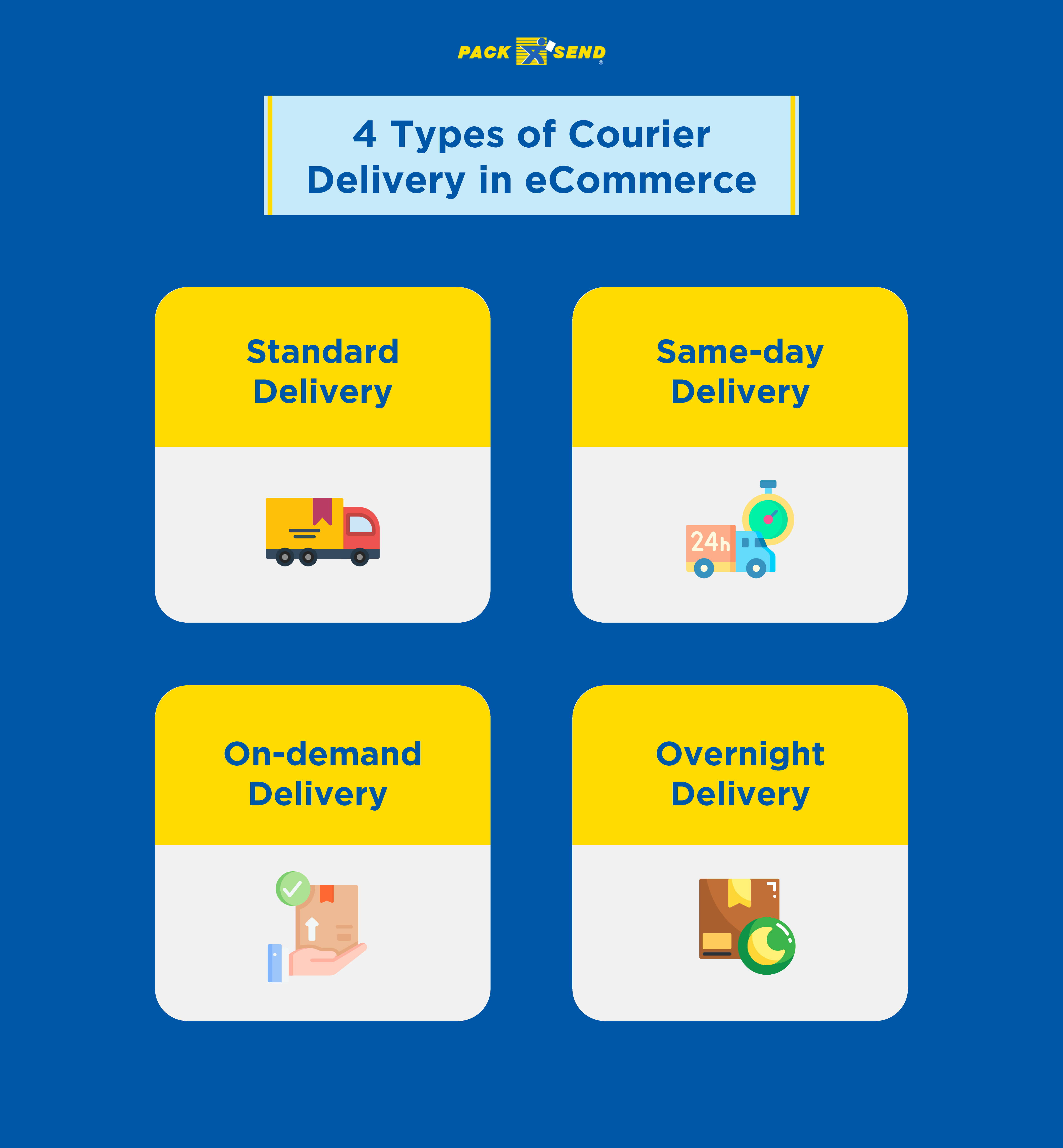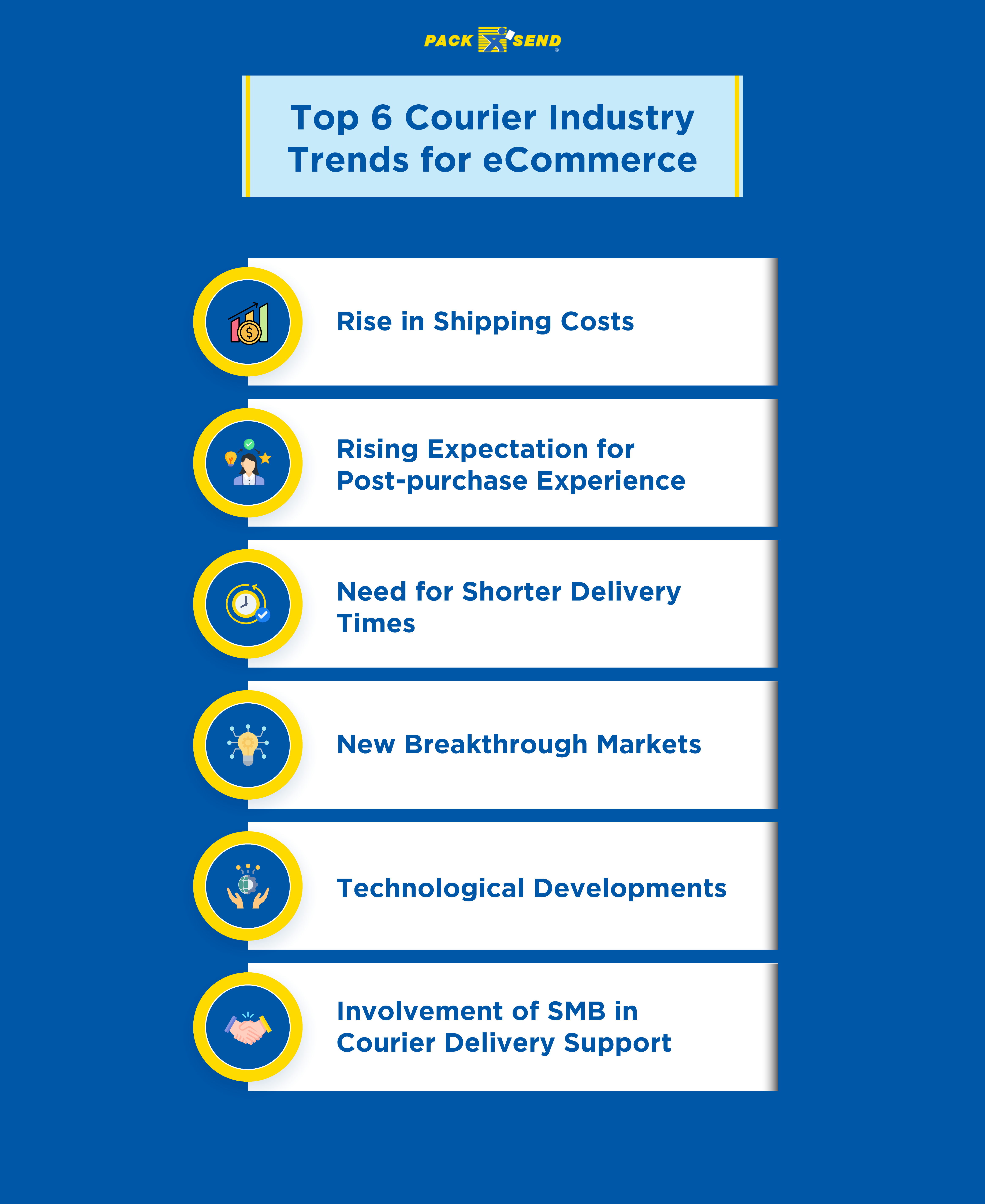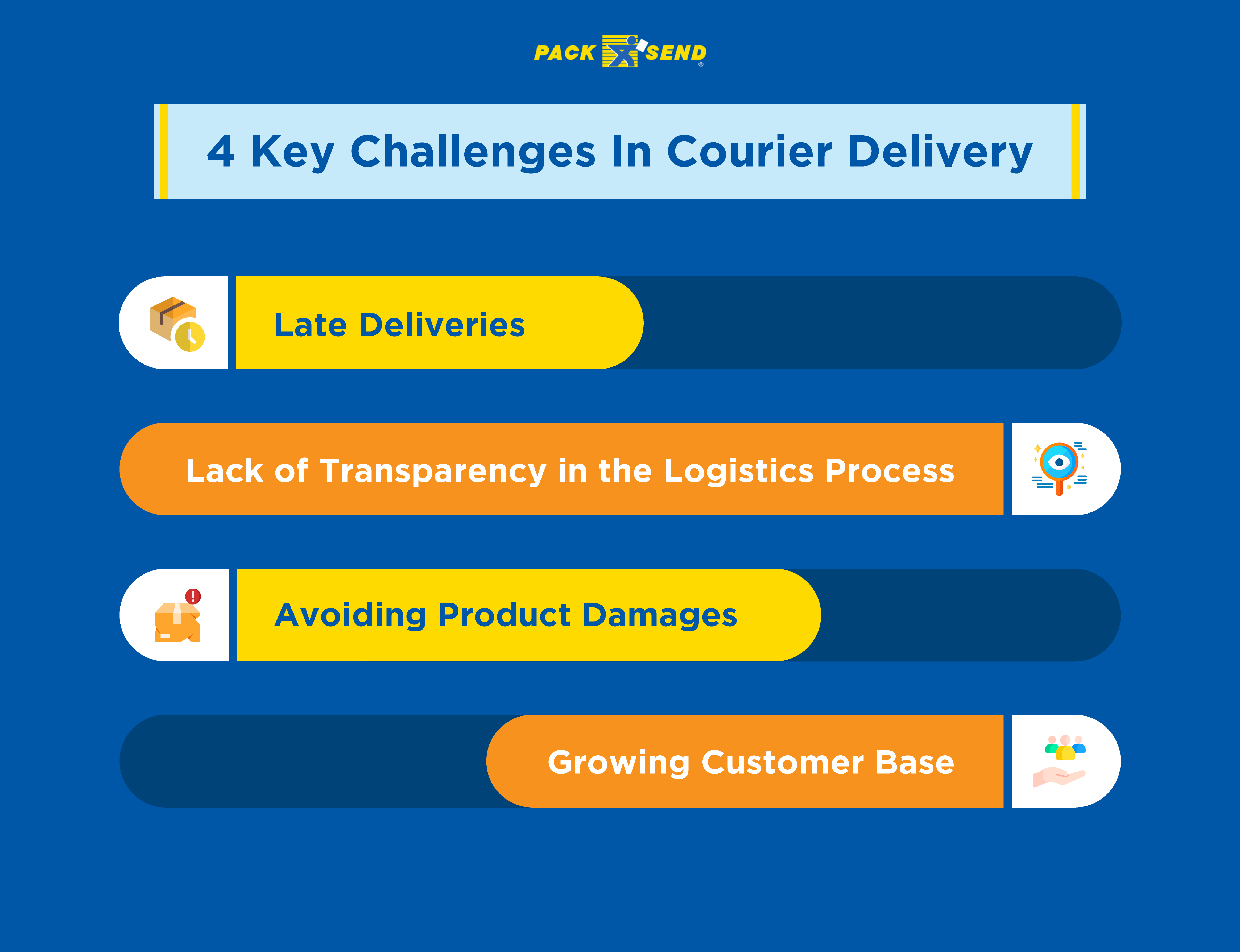An eCommerce supply chain is nothing without its seamless delivery process. 
As customers have embraced online shopping and eCommerce sales have skyrocketed, so has the need to meet delivery expectations and have an efficient courier delivery.
Courier delivery services have witnessed a drastic change in their operations. And the supply chain keeps evolving, shaping the way for an agile delivery chain in the future.
In this article, we take a look at the latest delivery types, courier industry trends, and the upcoming challenges logistics providers and eCommerce companies will have to address.
Let’s go.
4 Types of Courier Delivery in eCommerce

As the eCommerce industry became more competitive, the courier delivery times became shorter. While three days used to be considered quick 10 years back, it’s considered standard time today.
In fact, 63% of the customers believe that a three-day delivery time is standard. This courier industry trend shows that if you want to survive in the eCommerce world, packages need to be delivered in three days or less. But not more than that. Some of the top courier delivery methods that online stores are using these days are:
1. Standard Delivery
Standard deliveries are one of the most common methods through which eCommerce companies courier their products to customers. Here the weight of the package is prioritised above its size.
Usually, the packages sent under standard deliveries weigh 50 kgs or less. In standard deliveries, the companies ensure that customers receive their packages within two or three business days. It is also one of the cheapest ways to deliver the products quickly to your customers.
2. Same-day Delivery
Unlike standard delivery, same-day deliveries, as the name suggests, are those that deliver the product within a few hours after your order is placed. But to do so, the customer needs to place the order before noon so that the courier delivery service provider has enough time to assemble and dispatch the order on the same day.
3. On-demand Delivery
While same-day deliveries are quick, they’re nothing as compared to on-demand delivery. On-demand delivery indicates the client’s package is delivered in minimal duration, usually not more than a half-day. On-demand delivery works well for some products like medical appliances and groceries. Basically, anything that is needed on an urgent basis.
4. Overnight Delivery
In standard deliveries, courier industries usually have time limitations where you cannot place orders after a certain time to get the order in the shortest time. With overnight delivery, there are no time restrictions. Overnight delivery can get you the package you ordered within 24 hours, regardless of when you place the order in a day. It works best for businesses that have to send parcels in emergencies.
Courier Industry Trends Statistics for eCommerce
The courier service market is projected to reach $658.3 billion by 2031 from $381 billion in 2021 with a projected CAGR of 5.7% (allied market research)

- The top most reason for cart abandonment is high shipping costs (Finance Online)
- 22% of customers abandon their cart because the shipping is too slow (Forbes)
- More than 95% of customers expect speedy resolution of shipping issues while in transit itself. (Thrive my Way)
- More than 50% of online shoppers consider the delivery conditions and only proceed with the purchase if they are clear about the same (Thrive my Way)
- 49% of customers consider same-day delivery as a motivating factor to make an online purchase. (Invespcro)
- 53% of customers will not make a purchase if they don’t know when they’ll receive it (Supply chain game changer)
- Having multiple shipping options can have a huge impact on customer satisfaction (Finance Online)
Top 6 Courier Industry Trends for eCommerce

Let’s take a look at some of the courier industry trends that the online stores and logistics companies should look out for.
1. Rise in Shipping Costs
The transition of goods from one place to another is the primary activity in a supply chain. But considering the current courier industry trends, it looks like there is going to be a consistent hike in fuel prices.
The rise in energy demand post COVID-19, Russia-Ukraine conflict, and expensive alternatives are all leading to a fuel price hike. Combine this reason with other reasons such as charges on delayed goods, inflation, and a shortage of staff at ports and at cross-border points, all contribute to the rising shipping costs.
The high shipping demand outweighs the capacity which may negatively influence the market growth. As a result of the rising shipping costs, ‘pay as you drive’ pricing is expected to become more popular amongst logistics companies in the future. There is also a rising use of AI and IoT to resolve aggregating price levels from fluctuating fuel prices.
2. Rising Expectation for Post-purchase Experience
Customers are increasingly focusing on after-sales experiences. These range from getting personalised delivery, round-the-clock customer service, to shipping insurance, and return services in case they change their minds or the product wasn’t up to their expectations.
To address the growing importance of post-purchase, logistics companies and eCommerce need to collaboratively work on elevating customer service post-purchase. There needs to be increased focus on return logistics, automating customer support for first-level support, and revamping packaging to improve personalisation.
3. Need for Shorter Delivery Times
As we saw before, same-day deliveries and 2-day delivery are no longer just trends. They’re getting normalised, especially by eCommerce giants like Amazon. The courier industry trend of two-day delivery along with expedited shipping has stayed intact for a long time.
To make it in the competitive eCommerce market space, speeding up the delivery process is of utmost importance in the future. Fast deliveries are also one of the reasons customers go through with the purchase. The need for shorter delivery times is also changing the warehousing and storage strategies for online stores. Micro-fulfilment centres are gaining traction to meet the speedy delivery expectations of customers.
4. New Breakthrough Markets
While the US has long-standing as one of the top online shopping markets, there are emerging countries that are experiencing a breakthrough in eCommerce. Some countries that have a higher spending power are leading the international eCommerce markets. For delivery services, that means global opportunities and addressing the challenges of international courier services. Some of these markets include Australia, Canada, Singapore, Brazil, and the UK.
5. Technological Developments
Technological development has been a courier industry trend for a while but it's because the industry is constantly evolving in terms of adapting new tools and automation. It is because of technological developments that the courier industry is able to meet the quick delivery expectations of the customers and also provide exceptional customer service.
The latest addition to the technological stack in the delivery industry is the use of IoT and AI in transportation management. It helps logistics companies have clear visibility across the supply chain processes and communication of data in the global transportation network. It is also aiding companies in forecasting routes and gathering critical data needed to improve deliveries.
6. Involvement of SMB in Courier Delivery Support
With the rising demand for online shopping, eCommerce marketplaces are looking for ways to improve their order fulfillment process and provide fast and efficient delivery to their customers. That’s where small and medium-sized businesses (SMBs) are stepping in.
A lot of SMBs are partnering with eCommerce marketplaces to micro-fulfilment (or local fulfilment) and delivery services. Ecommerce marketplaces like Amazon, Walmart, and eBay have their own logistics network, but they also rely on third-party courier services to ensure timely and efficient delivery of their products.
It helps ecommerce marketplaces improve their delivery times, reduce costs, and provide a better customer experience.
This indicates a new trend in courier industry where SMBs have an active involvement in logistics processes and the supply chain.
4 Key Challenges In Courier Delivery

While some courier delivery business trends promise significant growth, there are some challenges that the industry will have to overcome in the future. Let’s take a look at them.
1. Late Deliveries
And while it’s critical to meet the exceedingly high expectations for delivery, it is easier said than done. There are a hundred different risks of transporting the product from one place to another as well as the risks of unexpected delays owing to natural circumstances.
This can result in high shipping costs as well as customer dissatisfaction. To avoid this, courier delivery industries can establish micro-fulfilment centres to avoid delivery delays and have an economic means of timely delivery as you scale.
2. Lack of Transparency in the Logistics Process
Supply chain can only be optimised if there is a clear flow of communication and visibility. What are the problems all departments are facing? How can you collaboratively solve them to achieve timely delivery? Everyone in the supply needs to have answers to these questions and that is only possible with transparency.
But with too many parties involved and a lack of effort for collaboration, establishing transparency is a challenge. You can do so via having dedicated communication channels and integrating technology wherever needed to improve tracking in the delivery processes.
3. Avoiding Product Damages
Nothing is more off-putting for a customer than receiving a faulty product. And while you ensure all the packaging protocols to protect the products, there are some things that are out of your control. In such cases, it is best to take responsibility and offer benefits such as free replacement or discounts on the next products.
4. Growing Customer Base
As the world shops online, there is an increasing demand for logistics and courier delivery services. A courier company not only needs to keep up with the increasing fuel prices but also an increasing number of orders each day. The courier delivery company works with multiple eCommerce entities and handles the delivery, orders, and return logistics as well.
To better manage everything, automation and outsourcing is the key. Tools like delivery management systems and order management systems help with addressing the increasing demand and work with minimum errors. You can also look for 3PL providers that take care of your end-to-end delivery requirements.
>Keep Up with the eCommerce Courier Industry Trends
As an eCommerce company, delivery and logistics planning can be overwhelming. Especially when trends are evolving at a fast pace. It is ideal to hire a third-party logistics provider that’s aware of the courier industry trends and knows how to navigate around the challenges in eCommerce deliveries.
Contact us at PACK & SEND to learn about how we can help you provide timely deliveries and enhance customer satisfaction.
Image source: Maximize Market Research
